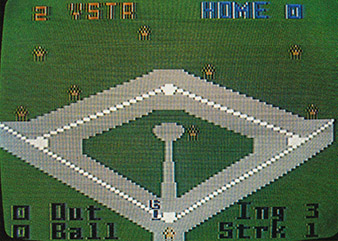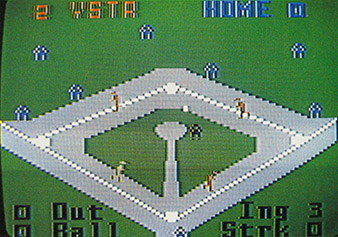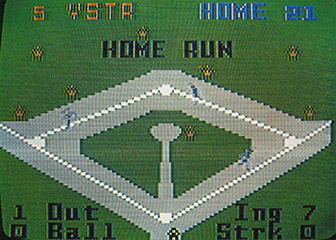
Major League Baseball
With the possible exception of hot dogs and apple pie, there’s nothing quite as American as the game of baseball (never mind that it’s equally popular in Japan). Thanks to the patriotic programmers at Mattel, you can enjoy the Great American Pastime in your own livingroom any time of the year with Intellivision Major League Baseball.
The Intellivision game not only plays like real baseball, it looks like real baseball and even sounds like real baseball.
You play the game on a real Baseball diamond. There are nine players on a team. The umpire calls the balls, strikes, and outs. A scoreboard records the progress of the game. You play for nine innings. If the score’s tied after regulation play is over, you go into extra innings.
Most professional Baseball rules apply in Intellivision’s MLB. You can hit singles, doubles, triples, and even slug out a home run. Your runners can steal bases and can be picked-off base. Defensively, you can perform double and even triple plays.
You’ll hear simulated crowd cheers when you get a hit. Hit a home run and they’ll go wild! You’ll even hear the Intellivision umpire call you out! Actually, it sounds more like an electronic frog calling you out, but you don’t want to argue with the umpire, do you?
Mattel, Inc.
for Mattel Intellivision
NA/$25.00-30.00
2 players
Rating: R
Graphics: 9
Game Play: 8
Longevity: 8
OBJECTIVES
To score more runs than your opponent in a nine-inning game of Baseball.
CONTROLLERS
Major League Baseball is played using the Intellivision controllers and the keyboard overlays included with the game cartridge. The home team (in blue on the screen) uses the right controller; the visiting team (in red) uses the left controller.
Defensive Controls: More than anything else, MLB is a game of defense. Once you’ve mastered the defensive controls, you’ll be able to play like a pennant contender every time. The keyboard overlay shows each of the nine players in their positions on the field. When the batter hits a ball, you must “activate” a player in order to be able to retrieve it and throw the ball to a base. There are no fly balls in MLB, only grounders. To field a ground ball you must first press down on the illustration of the player you want to activate. For example, if a ball is hit deep to left, you would press the left fielder. This will change the fielder’s color from red or blue (depending on which team he’s on) to black. This means he is activated.
You must now press down on the outer edge of the direction disc in the direction you want him to move (up, down, left, right, or one of four diagonal directions in between). Maneuver him over to the ball — he will automatically pick it up. Now, he must throw the ball, either to a baseman, to get the batter out, or to the pitcher if the runner has already stopped at a particular base.
Let’s go back to our left fielder. The ball was hit deep to left, you’ve activated the left fielder, and moved him over to the ball. The runner has just rounded first base and is headed for second. Immediately press the illustration of the second baseman on the overlay. The left fielder will whip the ball over to second. At the same time, the second baseman will run over to catch the ball and cover the base. If the ball gets there before the runner does — he’s out. If not, your opponent has a man on second.
You must then push down on the illustration of the pitcher to return the ball to the mound for the next pitch. A new batter will step to the plate, and the action will begin again. It’s not really as tough as it sounds, though it can be a bit clumsy at times. Again, with practice, you’ll be a pro.
Pitching is much easier. You can throw one of eight pitches by pressing the appropriate spot on the outer edge of the direction disc. Clockwise, beginning at 12:00, they are: fast ball, fast outside curve, outside curve, slow outside curve, slow ball, slow inside curve, inside curve, and fast inside curve. If the batter does not hit the ball, you must have the catcher return it to the mound by pressing the pitcher’s illustration on the overlay.
If a base runner is attempting to steal a base during or after the pitch, have the catcher whip the ball to the player covering that base in order to tag him out.
Offensive Controls: The game gets much easier when you’re up to bat. When the pitcher hurls the ball at you, all you need do is press one of the action buttons on either side of the controller to swing at the pitch. Pressing the top button will cause the batter to swing away at the pitch. If you time your swing so that you hit the ball exactly as it crosses the plate, the ball will generally sail toward center field. Swing a little early, and it will go toward left field; swing a little late and it will head for right field. If you swing away and miss, of course, it’s a strike — three and you’re out.
Pressing the bottom button will cause your batter to bunt the ball. When bunted, the ball will gently roll into the infield. Note that, unless it is thrown far inside or outside, you cannot miss a pitch if you bunt the ball. Thus, if you’ve got two strikes on you and you don’t want to risk striking out, try bunting. If nothing else, you may catch the opposition napping, especially if they’re expecting you to swing away.
When you hit the ball, you can’t just stand there — you must run the bases. To advance the runner, press and hold the direction disc to the right. To stop the base runner, take your finger off the disc. If you overrun the base, stop him and press the left side of the disc. This will move him back toward the base. If you’re not exactly on the base and the opposition throws the ball to that base, you can be tagged out.
You can also lead off and steal bases in the same manner. With more than one runner on base, the direction disc controls only the lead runner. No double steals are allowed. For example, with runners on first and second, if you press the direction disc to the right, the man on second will steal third base. The man on first base, however, will stay on first.
Specific strategies on fielding, pitching, hitting, and baserunning will be presented on the pages that follow.
ELEMENTS
Players: The visitors are dressed in red uniforms and bat first. The home team is dressed in blue and bats last.
Scoreboard: The scoreboard at the bottom of the screen automatically keeps track of the innings, outs, balls, and strikes. The scoreboard at the top of the screen keeps track of each player’s score.
VARIATIONS

Your players are all in position, ready to begin a new game.
Major League Baseball features four game variations for two players. Basically, these variations determine the speed of all the elements in the game — pitches, runners, fielders, etc. “Major League” speed is the fastest, and “Spring Training” speed is the slowest (“Triple-A” and “College” are in between). We like the Major League speed, but you will probably want to play the game at its slowest pace it you’re a beginner.
STRATEGIES
In Major League Baseball, you can never play against the computer. You can only play against another real, live person. Obviously, this means we can’t give you a single strategy that will work every time. Some of your opponents will be best at fielding, some at pitching. It will be up to you to exploit their individual weaknesses. It’s up to us to tell you how to do that.
Defense: Major League Baseball is not a game of pitching, despite the fact that you can throw eight different pitches. A good batter will know a ball when he sees it coming. He’ll prefer to wait for a strike he can hammer out of the park. So, mix up your pitches, for sure, but don’t expect any no-hit games. This is a game of fielding and baserunning.

A base hit up the middle! Note that the pitcher has been “activated.” He is closest to the ball. In this situation, the pitcher should throw to home base to prevent the other team from scoring a run.
Remember, there is no such thing as a fly ball in this game — all runners must be either tagged or forced out at a base. So a good defensive player will try to pick up everything with his infielders. Keep your two fingers on the shortstop and second baseman.
When a ball is hit, chase it down with either of these two infielders. You’ll need a good jump on the ball, though, so be prepared to pick the right man for the job. No sense chasing down a bunt with the right fielder!
Double plays are possible, particularly if the second baseman can tag a runner and then throw to first. It’s somewhat harder, perhaps impossible, to perform two throws to get those outs.

A round-tripper!
The biggest worry for the pitcher is when there are men on base, because it’s easy to steal in this game. However, the pitcher can pick off the runner simply by throwing the ball to the baseman covering the runner. If a runner has too big a lead he won’t get back to the bag in time. On the other hand, if you try to pick him off, he might just head for second, third or even home base, in which case you’ve got to run him down.
Use the man with the ball to chase the runner almost all the way to the next base, then toss it to the man covering that base. If the pitcher suspects a steal, he can simply activate the catcher. The catcher will jump out in front of the plate and receive the ball, ready to whip it to second or third. There is no way a runner can get a jump on this strategy and he will be forced back, or out, if you get lucky. Use these pitch-outs to limit stealing. When the pitcher suspects a bunt, he should be ready to charge for it himself.
Offense: Offense is somewhat easier than defense, but that doesn’t mean you can take it easy. Press the defense. Keep them on their toes. Steal as often as possible. Take large leads sometimes. Hit from one field to another, and throw in a few bunts with men on first or second base.

TESTIMONIAL
“When I’m playing defense and the ball goes to left field, I will throw the ball to first base. The runner will probably run to second, and I can pick him off by throwing the ball between my first and second basemen.
“If there is a man on second base and one out, I will intentionally walk the batter and go for the double play.”
Mark Vecci, age 14
Bridgeview, Illinois
Don’t forget the hit-and-run plays: With a good pitch on the way, send your base runner to the next base and take a swing at the ball. In fact, on every pitch with a man on base, the runner should jump as if he’s going to run and make the final decision to do so once the batter takes a good look at the ball. If it doesn’t look like a good pitch, return to the base. If it’s a slow ball, keep going.
Remember, you want to vary your behavior. The first time you get a man to first base, swing at the first pitch and simultaneously try to steal second. Chances are you’ll make it, and your opponent won’t know how to psyche you out. He’ll wonder if you’re stealing a base in every situation from then on. Of course, you won’t. Next time, let your batter take three or four pitches without swinging, while you repeatedly fake a steal. Get used to watching your opponent out of the corner of your eye. When he is running you down between bases and you see him press a button, head the other way immediately because it will mean he is throwing the ball.
With men on base, the lead runner is the only one you control, so don’t watch the man going to first because he is controlled automatically. He will not overrun first base no matter what you’re doing with the direction disc.
In batting, the same general rules that apply to real baseball also apply to this cartridge. Swing early and the ball will go to left field, swing late an it will go to right. Hit to the field away from where your lead base runner is heading. A ternate your swings to accommodate slightly inside or outside curves — they can be hit for distance Just like a fastball. Hit a home and the game will rub it i to your opponent.
But whatever you do, don’t stand in the batter’s box sweating when the pitcher delays. That is a ruse only little leaguers should fall for. There just aren’t any pitches your opponent could be thinking of throwing that are worrisome in this game. Keep your mind on the baserunning.
Source Pages





